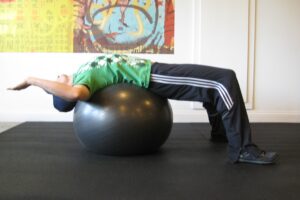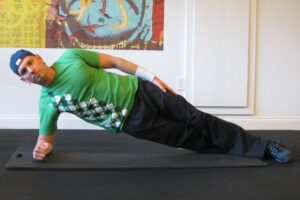
What are the best golf core exercises?
Probably NOT the ones you think!
Traditionally, the sit-up and the crunch (a variation of the sit-up) have been the mainstay of core conditioning for everyone from the out-of-shape couch potato to elite athletes to the military physical entrance testing.
Now there is absolutely nothing inherently wrong with these exercises, or any of the variations of trunk flexion movements.
By “trunk flexion”, I am simply referring to the action of curling your torso forward, toward your feet.
All things being equal, I want my golfers to have stability, range of motion and strength in ALL directions, including flexion.
But these days, all things are rarely equal… and the problem I see 99% of the time is that golfers come in for their first assessment already stuck in flexion!
This is caused by many factors, but is usually a result of poor postural habits in regards to the seated workplace, seated home-life, driving etc.
As discussed in this post on mobility – flexion kills rotation!
So if you are currently part of the 99%, then the last thing you need to be doing is to create more trunk flexion by performing sit-up or crunches.
Actually, what you want to do first is to stretch out the “crunch muscles”.
The best way to do that is to use a Swiss Ball.
Swiss Ball Ab Stretch
This movement not only stretches out the tight abdominals, but also helps to restore extension (bending backwards) to your spine (crucial to your golf swing).
1. Sit on an appropriate size Swiss Ball, then walk out and roll back to the point that your head is just barely touching the ball.
2. Place your arms out at 90 degrees, as this will get a nice stretch on your chest muscles.
3. Breath deeply into your core and feel for certain areas that might be tighter than others.
4. This stretch can be performed for up to 1 minute.

NOTE 1: Stop this stretch immediately if you feel dizziness, nausea or other unusual symptoms. These often relates to an issue in your cervical spine. See your doctor or consult a specialist.
NOTE 2: Do not perform this stretch if you have any arthritis of the spine.
Once you get done lengthening out the short and tight muscles in the front of your mid-section, it’s time to actual strengthen the vitally important, but often neglected golf core muscles with the exercises below:
Four Point TVA
The deepest layer of your abdominal wall is called the TVA. When functioning properly, it acts as your internal weight belt – protecting you from the rotational stress of the golf swing, and allowing you to develop speed and power.
This muscle is odd, in that it’s trained in a very different way than the other golf core muscles.
When activated, the TVA draws your navel inwards towards your spine.
It “makes you skinny”, at least for the moment 😉
Here is the relatively easy way to train your TVA:
1. Assume the 4-point kneeling position in the photo below.
2. Take a deep diaphragmatic breath and allow your abdominal wall to relax and your belly to drop down.
3. Without exhaling – draw the navel inward as you activate the deep abdominal wall. Your spinal curves should not change.
4. Continue to draw inward, getting skinnier as you do, and exhaling slowly for the duration of the repetition.
5. Hold the “skinny” position for ten seconds. Inhale and repeat for 10 reps.
6. The most important aspect of this exercise is to only use modest effort. If you “bear down” too hard, you will be utilizing the outer rectus abdominis muscle.


Dead Bugs (Lower Ab Drills)
Lie on your back with your knees bent and your feet on the floor.
Place your hands under your low back, with palms against the floor and middle fingertips just touching. You will likely have a small gap between your fingers and your spine.
Now tilt your pelvis towards the floor – flatten your back, so that your spine is pressing down hard against your hands.
Now slowly raise one foot off of the floor, until your thigh is at 90 degrees to the floor. The goal is to keep your back flat and the same solid pressure on your hands.
Next, slowly lower your foot back to the floor. Again, pay close attention to your ability to keep the same constant pressure from your spine on your fingers.
Perform 10-20 reps each side, alternating from right leg to left leg with each repetition.


Advanced Dead Bugs
This advanced version starts the same as the one above, but after bringing one knee up, you then bring the other knee up, and lower BOTH of them down together.
This is a substantial increase in difficulty. Perform 10-20 repetitions.



Side Note: This exercise is called “dead bugs” because you are on your back with your legs flailing in the air. Yeah, I know, physical therapist humor leaves more than a bit to be desired…
Static Side Plank
The obliques muscles are on the sides of your core, and are important in creating rotational power.
But before we actually integrate any rotation exercises into a workout routine, we first want to strengthen them up in a static (non-moving) fashion. This ensures that you can perform the power golf moves later without getting injured.
1. Start side lying with your elbow directly under your shoulder joint.
2. Position your legs in either the Modified or Standard variation.


These three exercises make up the basic foundation of our Level 1 Renegade Golf Core Conditioning Program.
There are LOTS of more advanced, exciting (dare I say “sexy”) core training exercises that I will be covering in the next few weeks. But first, master these three golf core movements in order to reduce your chance of injury, stay pain-free and play to your peak potential.
Get “Renegade” to the core… and get after Old Man Par!
If you enjoyed this post, then join 13, 153 other golfers and get free email updates >>> Click Here<<<
